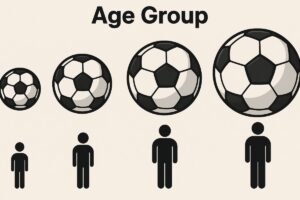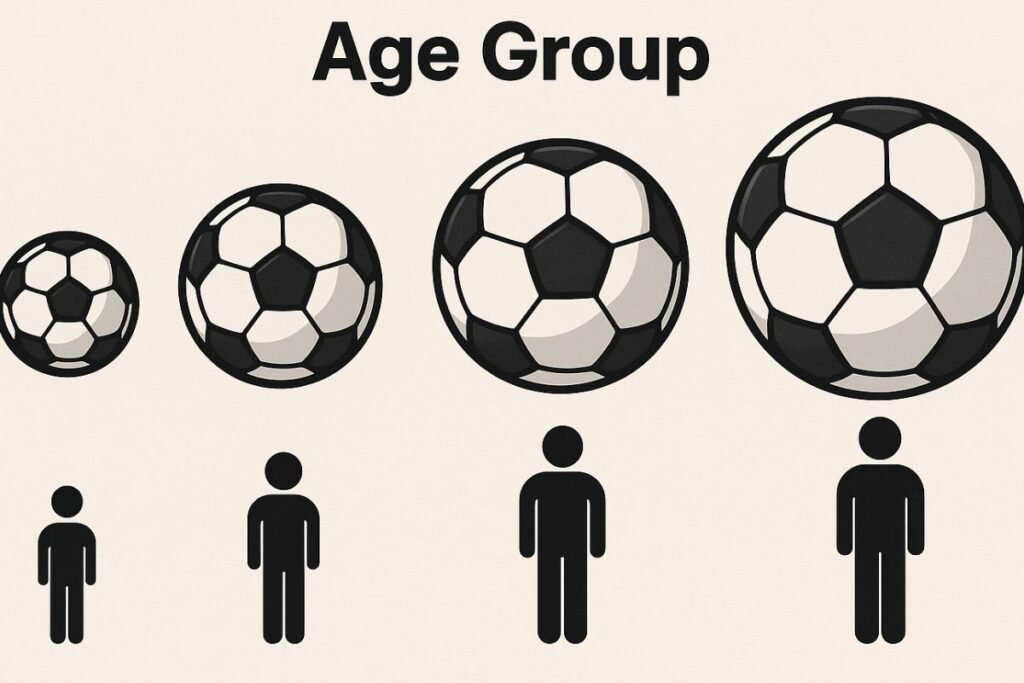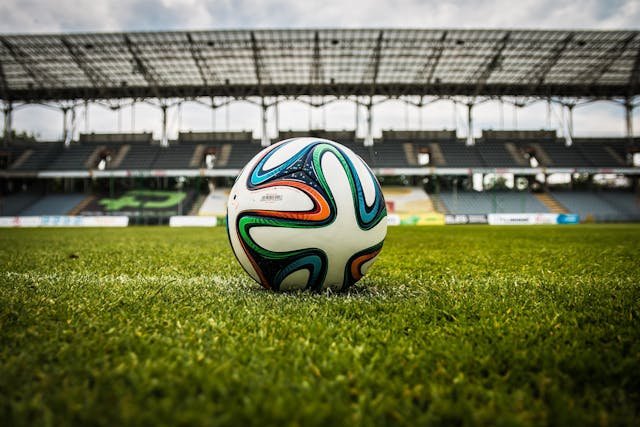Soccer is one of the world’s most popular sports, played by over 270 million people worldwide. Whether you or your child are beginners or club-level players, a key question often arises: What Size Soccer Ball for Age Group ? Choosing the correct ball size is essential for developing proper skills and staying safe on the field. In this comprehensive guide, we explain the official soccer ball sizes (1 through 5), their recommended age ranges, and why getting the size right matters for players from toddlers to adults.
Even young children (pictured above) benefit from an age-appropriate ball. Coaches emphasize that the right soccer ball size “significantly impacts a player’s learning of the game”. For example, smaller balls allow young kids to control the ball more easily, while using an oversized ball can lead to improper technique and frustration. By matching a soccer ball to a player’s age and strength, children develop correct kicking and dribbling habits safely.
Choosing the correct ball size isn’t just about following rules—it has real benefits. A properly sized ball helps players execute successful touches and build confidence. It also reduces injury risk: balls too large or heavy for a child can cause strains or accidents, especially during headers. In short, right-sizing the ball makes the game challenging yet achievable for every age group.
Why Soccer Ball Size Matters?
- Skill Development: Age-appropriate balls let players learn techniques effectively. Younger players using an adult-size ball often develop improper techniques that are harder to fix later.
- Control & Confidence: A smaller, lighter ball is easier to kick and control, leading to more successful touches. When kids struggle with an oversized ball, frustration can quickly diminish their interest.
- Safety: Using the correct size minimizes injury risk. Balls that are too heavy or large increase the risk of sprains and bruises for children.
- Game Experience: Correct sizes ensure the game scales with the players’ abilities. Each age group can enjoy soccer in a way that is appropriately challenging.
Experts agree that selecting the appropriate ball size “is crucial for their skill development and safety”. For parents and coaches, this means matching the ball size to the child’s age and ability level. The charts and guidelines below will help answer “what size soccer ball” to use at each stage.
Soccer Ball Sizes by Age :What Size Soccer Ball for Age Group
Soccer balls come in five standard sizes (1–5), each designed for specific ages. Below is an overview:
- Size 1 (Mini): Circumference ~18–20 inches (45–51 cm). Used mainly for toddlers (under ~4 years) or as a “skills” ball for practice. Ideal for very young children to practice kicks and coordination. E.g., children under 4 often start with a Size 1 ball.
- Size 2 (Toddler/Midi): Circumference ~20–22 inches. Designed for ages 3–5. Used in some preschool programs and introductory play. Note: Size 2 balls are less common than the others.
- Size 3 (Junior): Circumference ~23–24 inches. Standard match ball for players aged 5–8 years. It’s light (around 300–320g) and easier for smaller kids to kick and handle.
- Size 4 (Youth): Circumference ~25–26 inches. Used by players aged 8–12 years (roughly U9–U12 teams). Heavier (350–390g) than Size 3, it bridges the gap between junior and adult balls, and is also the official futsal (indoor) ball.
- Size 5 (Adult): Circumference ~27–28 inches. The standard regulation ball for ages 12 and older. It weighs 410–450g and meets all FIFA requirements (68–70 cm circ, 410–450g weight). This is the ball used in professional and adult play.
Each size’s range is given by FIFA and youth leagues. For a quick reference:
- Ages 3–5: Size 1 or Size 2. (Some coaches prefer Size 2 for 3–5, Size 1 for under 3.)
- Ages 5–8: Size 3.
- Ages 8–12: Size 4.
- Ages 13+ (Adults): Size 5.
These guidelines align with organizations like US Youth Soccer and FIFA. Always double-check any specific league rules, as some clubs may tweak these recommendations.
Choosing the Right Ball by Age
Below we address common age ranges and questions:
Toddlers and Young Children (Ages 3–5)
For 3- to 5-year-olds, the recommended ball is a Size 1 or 2. Very young players (under 3–4) often start with a Size 1 mini-ball (18–20 in). This tiny ball builds confidence and foot skills without overwhelming them. Adidas notes: “If you’re looking for a ball for someone younger than four years old, a size one ball will do the trick”. Many preschool programs also use a Size 2 ball (20–22 in) for kids aged 3–5.
In practice: If your child is 3 or 4, a Size 1 mini or Size 2 toddler ball is ideal. By age 5, most players are ready to move up to Size 3. Coaches often field U5 teams with Size 2, then switch to Size 3 around age 6.
Children (Ages 5–8)
Players 5 to 8 years old should use a Size 3 ball (23–24 in). This is the standard youth match ball for U6–U8 leagues. Size 3 balls weigh about 11–12 oz (300–320g), making them light enough for kicking and controlling. At this stage, children develop basic soccer techniques, and a size 3 ball is “perfect for teaching proper ball handling and control”. Using size 3 avoids putting undue strain on young legs and helps them pass and dribble accurately.
What about 6-year-olds? A 6-year-old falls in this same bracket (5–8), so a Size 3 is recommended. The ball transitions children from beginner drills to more organized 5v5 or 7v7 games. For example, a typical U8 league will always use Size 3 balls.
Older Kids (Ages 9–12, U12)
Players roughly 9 to 12 years old (U9–U12) should use a Size 4 ball (25–26 in). This larger ball weighs around 350–390g and starts to feel more like a regulation ball, yet it’s still manageable for preteens. Size 4 is the norm for U9 through U12 leagues. Coaches recommend size 4 at this age to “get older children accustomed to the size and weight of a regulation ball without overwhelming them”.
For instance, if a 10-year-old asks “what size soccer ball should I use?”, the answer is a Size 4. Nearly all U10 and U12 teams play with Size 4. (Some very strong 11–12-year-olds begin practicing with Size 5, but official matches usually remain Size 4 until players turn 12–13.)
Preteens and Teens (Ages 13+)
By age 13 and up, it’s time for the full-size, standard Size 5 ball (27–28 in). This is the official ball for teenagers, adults, and pro players. FIFA’s Laws (Law 2) specify that the regulation ball must be Size 5 with a circumference of 68–70 cm and weight 410–450 g. In practice, all youth teams U13 and older use Size 5.
So if someone asks “what size soccer ball for adults?” or “what is a standard soccer ball size?”, the answer is Size 5. Size 5 balls are used in all high school, college, and professional matches. The image below shows an official match ball (size 5):
Figure: An official size 5 soccer ball on a field. Adult and professional players use Size 5 (27–28 in circ) as per FIFA rules.
What is the Official/Regulation Size?
In soccer, a “standard” or “regulation” ball refers to Size 5. FIFA’s Laws of the Game dictate that this match ball be 68–70 cm in circumference (27–28 in) and 410–450 grams in weight. This specification ensures consistency at the highest levels. For example, the World Cup and professional leagues use size 5 balls that meet these rules.
To summarize: Standard/Regulation ball = Size 5 (circumference 27–28 in, weight 14–16 oz). All players aged 12/13 and up should train and play with this official size.
(Note: Futsal, the indoor variant of soccer, actually uses a size 4 ball that is heavier and has less bounce – but that’s a special case outside standard outdoor play.)
Tips for Choosing a Soccer Ball
Beyond just size, consider these tips to ensure you pick the best ball for your needs:
- Check League Rules: Many youth leagues publish their required ball sizes. For instance, U.S. Youth Soccer closely follows FIFA’s recommendations: Size 3 for U8 and under, Size 4 for U9–U12, and Size 5 for 13+.
- Ball Weight: Smaller sizes are lighter. A Size 3 may be ~300g, while a Size 5 is ~430g. The lighter ball lets young legs strike more easily.
- Ball Pressure: Inflate balls to the recommended pressure (about 8.5–15.6 psi, or 0.6–1.1 atm). Underinflated balls are harder to kick accurately; overinflated balls can be dangerous.
- Material and Quality: Training balls may feel slightly different from match balls, but size is the same. Whether it’s a cheap practice ball or an official match ball, get the correct size.
- Personal Factors: Consider the player’s strength and comfort. Some very small kids might use a mini ball (Size 1) even up to age 5 for skill drills, or switch earlier if they are bigger for their age.
Choosing the right ball ensures players’ training and games are both safe and enjoyable. As one expert guide notes, using the correct ball size “helps young players develop appropriate techniques while preventing potential injuries”.

FAQs
- What size soccer ball for 3 year old? Toddlers (around 3 years) should use a Size 1 or 2 ball. Many coaches recommend a mini Size 1 for under-4 kids, while others use Size 2 (20–22 in) for ages 3–5.
- What size soccer ball for 4 year old? A 4-year-old also typically uses Size 1 or 2. By age 4, many leagues use Size 2, but Size 1 is still fine for introduction.
- What size soccer ball for 5 year old? Children aged 5 (U6) should use a Size 3 ball (23–24 in). This ball is lighter and easier to handle for early elementary kids.
- What size soccer ball for 6 year old? A 6-year-old falls in the same 5–8 age bracket, so use Size 3 as well.
- What size soccer ball for 8 year old? For an 8-year-old, the recommended size is 4 (25–26 in). (Some leagues move to Size 4 at age 8 or 9.)
- What size soccer ball for 10 year old? A 10-year-old should use a Size 4 ball. Size 4 is standard for ages 8–12.
- What size soccer ball for U12? Under-12 teams typically play with Size 4. (Once players turn 12–13, they transition to Size 5.)
- What size soccer ball for adults? Adults and high-schoolers use Size 5, the official match ball.
- What is a standard size soccer ball? The “standard” soccer ball is Size 5 (circumference 27–28 inches). This is the regulation size used in all official adult competitions.
- What size is a regulation soccer ball? A regulation match soccer ball is Size 5, meeting FIFA’s 68–70 cm circumference rule.
- What is standard soccer ball size? Again, Size 5 is the standard. All FIFA-sanctioned matches use Size 5 balls.
- What is the official size of a soccer ball? Officially, the soccer ball is Size 5 (27–28 in) for all adult matches.
Conclusion
By now you should have a clear answer to “What size soccer ball should you use by age group?”. In summary:
- Toddlers (≤5): Start with a mini (Size 1) or Size 2 ball.
- Kids 5–8: Use a Size 3 ball for practice and matches.
- Kids 9–12: Use a Size 4 ball.
- Teens/Adults (13+): Use the standard Size 5 ball.
Following these guidelines lets young players improve skills safely. Remember that FIFA and US Youth Soccer both recommend these size progressions. Always check with your league or coach to be sure you have the right size.
Got more questions? Drop a comment below and share this guide with friends or your soccer club. Using the correct soccer ball by age will help every player enjoy the game and play at their best!



